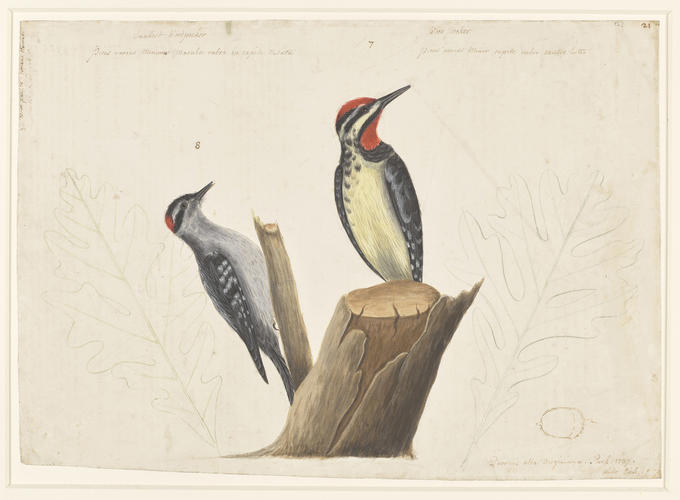-
1 of 253523 objects
The Yellow-bellied Wood-pecker, the Smallest Spotted Wood-pecker, the White Oak and the White Oak with pointed Notches 1722-26
26.8 x 37.5 cm (sheet of paper) | RCIN 924834
-
A watercolour of a yellow-bellied sapsucker (right, Sphyrapicus varius (Linnaeus)) and a downy woodpecker (leftt, Picoides pubescens (Linnaeus) with sketches of oak leaves, perhaps of the white oak (Quercus alba L.), behind. The drawing shows a tree stump upon which two birds are perched. The smallest bird, black and white with red nape, profile right. The yellow bellied bird faces front, head profile right. The sheet includes sketches of oak leaves and acorns. Inscribed in ink: (top left) Smallest Woodpecker Picus varius Minimus macula rubra in capite notata' and '8'; (top right) 'Woodpecker Picus varius Minor capite rubro ventre luteo' and '7'. In top right corner (in pencil and in ink): '21'. Inscribed in ink: (bottom right): Quercus alba Virginiana Park. 1787. White Oak'. The reference is to John Parkinson's Theatrum Botanicum, published in 1640.
Mark Catesby was born in Suffolk and was interested in natural history from an early age. In 1712, he travelled to the east coast of America with his sister Elizabeth, who had married a doctor who practised in Williamsburg, Virginia. Catesby spent seven years in Virginia collecting specimens and seeds for London buyers before returning to Britain. In London his drawings of birds and plants met with praise and a group of benefactors paid for his travel to Carolina in 1722. There, he made numerous drawings of the flora and fauna, working hard to ensure that his depictions were as helpful for an understanding of their subjects as possible. On his return to Britain, his drawings were reproduced in The Natural History of Carolina, Florida and the Bahama Islands, which appeared in a series of volumes between 1729 and 1747. The first volume was dedicated to Queen Caroline, the second to Augusta, Princess of Wales. The original drawings from the volumes, which had been in the possession of Catesby’s widow until her death, were purchased by George III from the London bookseller Thomas Cadell in 1768.
The watercolour was used as the basis for plate 21 in the first volume of the Natural History ('The yellow belly'd Wood-pecker', 'The smallest spotted Wood-pecker' 'The White Oak' and 'The White Oak, with pointed Notches').
For identification of the species depicted see James L. Reveal, 'Identification of the plants and animals illustrated by Mark Catesby for his Natural History of Carolina, Florida, and the Bahama Islands' in Phytoneuron 2013 and revised online version.
Provenance
Thomas Cadell; from whom bought by George III, 1768
-
Creator(s)
Acquirer(s)
-
Measurements
26.8 x 37.5 cm (sheet of paper)
Other number(s)
RL 24834Alternative title(s)
Picus Varius Minor Ventre Luteo; Picus Varius Minimus; Quercus alba Virginiana; Quercus Caroliniensis, virentibus venis muricata; Syringa baccifera
